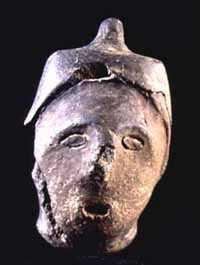
 |
Clay human effigy, Morton village, Fulton County. | |
|
The details of these figurines provide a glimpse of how Oneota people may have seen themselves. |
||
People archaeologists call Oneota arrived in the central Illinois River valley seven hundred years ago. They may have come from Iowa or farther up the Mississippi River, but archaeologists do not know why. Oneota people were slightly shorter than Mississippian people. The average male was 5' 5" tall, while females were 5' 3" tall. In some communities, poor diet led to a variety of diseases and tooth decay, and many people suffered from infectious diseases. Many people lived past the age 50, but women often died between the ages of 15 and 25, probably due to complications associated with childbirth.
Nearly half of the Oneota people buried in a cemetery in Fulton County died as a result of violence. Archaeologists do not know what caused the violence, but it may have been due to both conflicts between Mississippian residents of the river valley and the recently arrived Oneota, and conflicts with other Oneota people as well.
People called Caborn-Welborn by archaeologists lived near the mouth of the Wabash River. They may have been the descendants of Mississippian people living in the Ohio River valley.
It is not yet clear which Native American tribes are the descendants of the Oneota or Caborn-Welborn people.
|
|
Copyright © 2000 Illinois State Museum